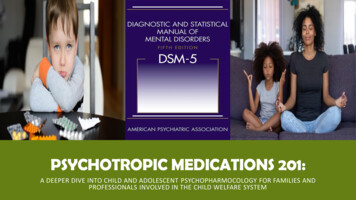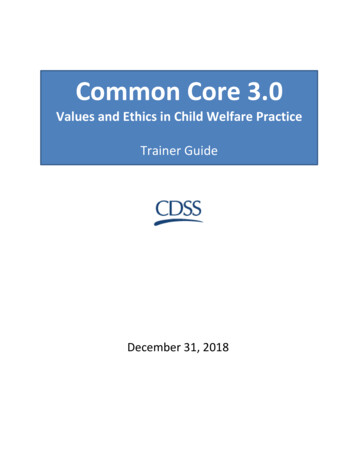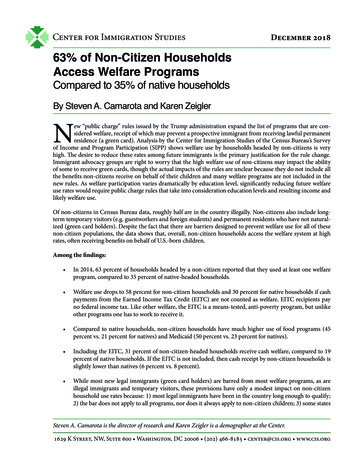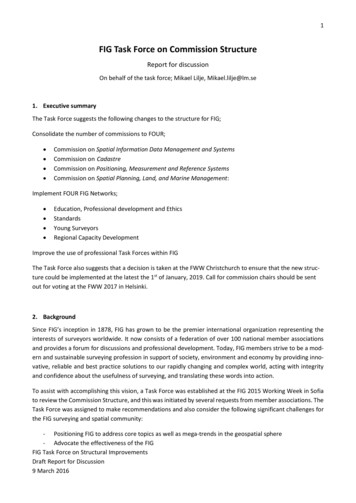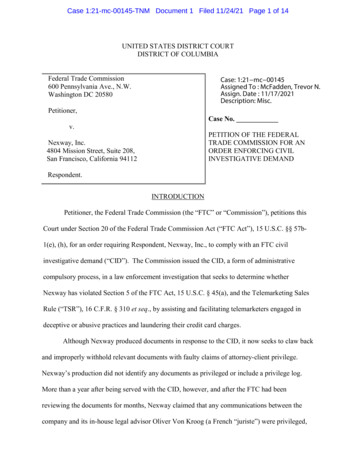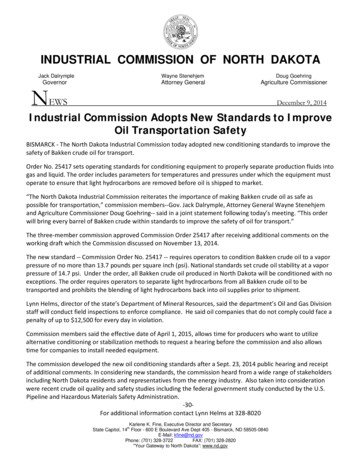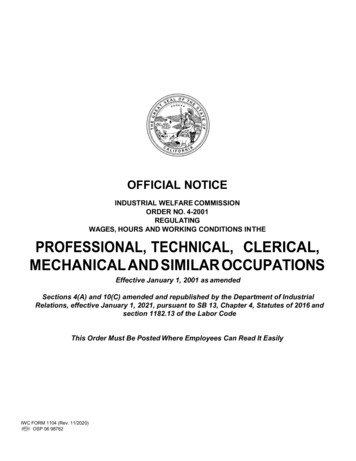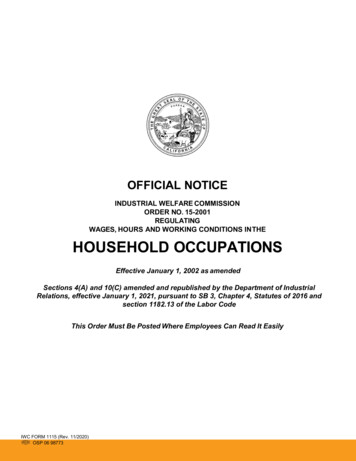
Transcription
OFFICIAL NOTICEINDUSTRIAL WELFARE COMMISSIONORDER NO. 15-2001REGULATINGWAGES, HOURS AND WORKING CONDITIONS IN THEHOUSEHOLD OCCUPATIONSEffective January 1, 2002 as amendedSections 4(A) and 10(C) amended and republished by the Department of IndustrialRelations, effective January 1, 2021, pursuant to SB 3, Chapter 4, Statutes of 2016 andsection 1182.13 of the Labor CodeThis Order Must Be Posted Where Employees Can Read It EasilyIWC FORM 1115 (Rev. 11/2020)OSP 06 98773
INDUSTRIAL WELFARE COMMISSIONORDER NO. 15-2001REGULATINGWAGES, HOURS AND WORKING CONDITIONS IN THEHOUSEHOLD OCCUPATIONSTAKE NOTICE: To employers and representatives of persons working in industries and occupations in the State of California:The Department of Industrial Relations amends and republishes the minimum wage and meals and lodging credits in theIndustrial Welfare Commission’s Orders as a result of legislation enacted (SB 3, Ch. 4, Stats of 2016, amending section1182.12 of the California Labor Code), and pursuant to section 1182.13 of the California Labor Code. The amendments andrepublishing make no other changes to the IWC’s Orders.1. APPLICABILITY OF ORDERThis order shall apply to all persons employed in household occupations whether paid on a time, piece rate, commission, orother basis, unless such occupation is performed for an industry covered by an industry order of this Commission, except that:(A) Provisions of Sections 3 through 12 of this order shall not apply to persons employed in administrative, executive, or professional capacities. The following requirements shall apply in determining whether an employee’s duties meet the test to qualifyfor an exemption from those sections:(1) Executive Exemption A person employed in an executive capacity means any employee:(a) Whose duties and responsibilities involve the management of the enterprise in which he/she is employed or of acustomarily recognized department or subdivision thereof; and(b) Who customarily and regularly directs the work of two or more other employees therein; and(c) Who has the authority to hire or fire other employees or whose suggestions and recommendations as to the hiringor firing and as to the advancement and promotion or any other change of status of other employees will be given particular weight;and(d) Who customarily and regularly exercises discretion and independent judgment; and(e) Who is primarily engaged in duties which meet the test of the exemption. The activities constituting exempt workand non-exempt work shall be construed in the same manner as such items are construed in the following regulations under theFair Labor Standards Act effective as of the date of this order: 29 C.F.R. Sections 541.102, 541.104-111, and 541.115-116. Exemptwork shall include, for example, all work that is directly and closely related to exempt work and work which is properly viewed as ameans for carrying out exempt functions. The work actually performed by the employee during the course of the workweek must,first and foremost, be examined and the amount of time the employee spends on such work, together with the employer’s realisticexpectations and the realistic requirements of the job, shall be considered in determining whether the employee satisfies thisrequirement.(f) Such an employee must also earn a monthly salary equivalent to no less than two (2) times the state minimumwage for full-time employment. Full-time employment is defined in Labor Code Section 515(c) as 40 hours per week.(2) Administrative Exemption. A person employed in an administrative capacity means any employee:(a) Whose duties and responsibilities involve either:(i) The performance of office or non-manual work directly related to management policies or general businessoperations of his employer or his/hers employer’s customers; or(ii) The performance of functions in the administration of a school system, or educational establishment or institution, or of a department or subdivision thereof, in work directly related to the academic instruction or training carried on therein;and(b) Who customarily and regularly exercises discretion and independent judgment; and(c) Who regularly and directly assists a proprietor, or an employee employed in a bona fide executive or administrativecapacity (as such terms are defined for purposes of this section); or(d) Who performs under only general supervision work along specialized or technical lines requiring special training,experience, or knowledge; or(e) Who executes under only general supervision special assignments and tasks; and(f) Who is primarily engaged in duties which meet the test of the exemption. The activities constituting exempt workand non-exempt work shall be construed in the same manner as such terms are construed in the following regulations under theFair Labor Standards Act effective as of the date of this order 29 C.F.R. Sections 541.201-205, 541.207-208, 541.210, and 541.215.—1
Exempt work shall include, for example, all work that is directly and closely related to exempt work and work which is properly viewed asa means for carrying out exempt functions. The work actually performed by the employee during the course of the workweek must,first and foremost, be examined and the amount of time the employee spends on such work, together with the employer’s realisticexpectations and the realistic requirements of the job, shall be considered in determining whether the employee satisfies thisrequirement.(g) Such employee must also earn a monthly salary equivalent to no less than two (2) times the state minimum wagefor full-time employment. Full-time employment is defined in Labor Code Section 515(c) as 40 hours per week.(3) Professional Exemption A person employed in a professional capacity means any employee who meets all of the following requirements:(a) Who is licensed or certified by the State of California and is primarily engaged in the practice of one of the followingrecognized professions: law, medicine, dentistry, optometry, architecture, engineering, teaching, or accounting; or(b) Who is primarily engaged in an occupation commonly recognized as a learned or artistic profession. For the purposesof this subsection, ”learned or artistic profession” means an employee who is primarily engaged in the performance of:(i) Work requiring knowledge of an advanced type in a field or science or learning customarily acquired by a prolonged course of specialized intellectual instruction and study, as distinguished from a general academic education and from anapprenticeship, and from training in the performance of routine mental, manual, or physical processes, or work that is an essential partof or necessarily incident to any of the above work; or(ii) Work that is original and creative in character in a recognized field of artistic endeavor (as opposed to workwhich can be produced by a person endowed with general manual or intellectual ability and training), and the result of which depends primarily on the invention, imagination, or talent of the employee or work that is an essential part of or necessarily incident toany of the above work; and(iii) Whose work is predominantly intellectual and varied in character (as opposed to routine mental, manual,mechanical, or physical work) and is of such character that the output produced or the result accomplished cannot be standardizedin relation to a given period of time.(c) Who customarily and regularly exercises discretion and independent judgment in the performance of duties setforth in subparagraphs (a) and (b).(d) Who earns a monthly salary equivalent to no less than two (2) times the state minimum wage for full-timeemployment.(e) Subparagraph (b) above is intended to be construed in accordance with the following provisions of federal law asthey existed as of the date of this order: 29 C.F.R. Sections 541.207, 541.301(a)-(d), 541.302, 541.306, 541.307, 541.308,and 541.310.(f) Notwithstanding the provisions of this subparagraph, pharmacists employed to engage in the practice of pharmacy,and registered nurses employed to engage in the practice of nursing, shall not be considered exempt professional employees, nor shallthey be considered exempt from coverage for the purposes of this subparagraph unless they individually meet the criteria establishedfor exemption as executive or administrative employees.(g) Subparagraph (f) above shall not apply to the following advanced practice nurses:(i) Certified nurse midwives who are primarily engaged in performing duties for which certification is requiredpursuant to Article 2.5 (commencing with Section 2746) of Chapter 6 of Division 2 of the Business and Professions Code.(ii) Certified nurse anesthetists who are primarily engaged in performing duties for which certification is requiredpursuant to Article 7 (commencing with Section 2825) of Chapter 6 of Division 2 of the Business and Professions Code.(iii) Certified nurse practitioners who are primarily engaged in performing duties for which certification is requiredpursuant to Article 8 (commencing with Section 2834) of Chapter 6 of Division 2 of the Business and Professions Code.(iv) Nothing in this subparagraph shall exempt the occupations set forth in clauses (i), (ii), and (iii) from meetingthe requirements of subsection 1(A)(3)(a)-(d) above.(h) Except, as provided in subparagraph (i), an employee in the computer software field who is paid on an hourly basisshall be exempt, if all of the following apply:(i) The employee is primarily engaged in work that is intellectual or creative and requires the exercise of discretionand independent judgment.(ii) The employee is primarily engaged in duties that consist of one or more of the following:– The application of systems analysis techniques and procedures, including consulting with users, to determine hardware, software, or system functional specifications.– The design, development, documentation, analysis, creation, testing, or modification of computer systemsor programs, including prototypes, based on and related to user or system design specifications.– The documentation, testing, creation, or modification of computer programs related to the design of softwareor hardware for computer operating systems.(iii) The employee is highly skilled and is proficient in the theoretical and practical application of highly specializedinformation to computer systems analysis, programming, and software engineering. A job title shall not be determinative of theapplicability of this exemption.(iv) The employee’s hourly rate of pay is not less than forty-one dollars ( 41.00). The Office of Policy, Researchand Legislation shall adjust this pay rate on October 1 of each year to be effective on January 1 of the following year by an—2
amount equal to the percentage increase in the California Consumer Price Index for Urban Wage Earners and Clerical Workers. 1(i) The exemption provided in subparagraph (h) does not apply to an employee if any of the following apply:(i) The employee is a trainee or employee in an entry-level position who is learning to become proficient in the theoretical and practical application of highly specialized information to computer systems analysis, programming, and software engineering.(ii) The employee is in a computer-related occupation but has not attained the level of skill and expertise necessary to work independently and without close supervision.(iii) The employee is engaged in the operation of computers or in the manufacture, repair, or maintenance ofcomputer hardware and related equipment.(iv) The employee is an engineer, drafter, machinist, or other professional whose work is highly dependent uponor facilitated by the use of computers and computer software programs and who is skilled in computer-aided design software,including CAD/CAM, but who is not in a computer systems analysis or programming occupation.(v) The employee is a writer engaged in writing material, including box labels, product descriptions, documentation, promotional material, setup and installation instructions, and other similar written information, either for print or for on screenmedia or who writes or provides content material intended to be read by customers, subscribers, or visitors to computer-relatedmedia such as the World Wide Web or CD-ROMs.(vi) The employee is engaged in any of the activities set forth in subparagraph (h) for the purpose of creatingimagery for effects used in the motion picture, television, or theatrical industry.(B) Except as provided in Sections 1, 2, 4, 10, and 15, the provisions of this order shall not apply to personal attendants. Theprovisions of this order shall not apply to any person under the age of 18 who is employed as a baby sitter for a minor child of theemployer in the employer’s home.(C) The provisions of this order shall not apply to any individual who is the parent, spouse, child, or legally adopted child of theemployer.(D) The provisions of this order shall not apply to any individual participating in a national service program, such as AmeriCorps, carried out using assistance provided under Section 12571 of Title 42 of the United States Code. (See Stats. 2000, ch. 365,amending Labor Code Section 1171.)2. DEFINITIONS(A) An “alternative workweek schedule” means any regularly scheduled workweek requiring an employee to work more thaneight (8) hours in a 24-hour period.(B) “Commission” means the Industrial Welfare Commission of the State of California.(C) “Division” means the Division of Labor Standards Enforcement of the State of California.(D) “Emergency” means an unpredictable or unavoidable occurrence at unscheduled intervals requiring immediate action.(E) “Employ” means to engage, suffer, or permit to work.(F) “Employee” means any person employed by an employer.(G) ”Employer” means any person as defined in Section 18 of the Labor Code, who directly or indirectly, or through an agent orany other person, employs or exercises control over the wages, hours, or working conditions of any person.(H) “Hours worked” means the time during which an employee is subject to the control of an employer, and includes all thetime the employee is suffered or permitted to work, whether or not required to do so.(I) “Household Occupations” means all services related to the care of persons or maintenance of a private household or itspremises by an employee of a private householder. Said occupations shall include but not be limited to the following: butlers, chauffeurs,companions, cooks, day workers, gardeners, graduate nurses, grooms, house cleaners, housekeepers, maids, practical nurses,tutors, valets, and other similar occupations.(J) “Personal attendant” includes baby sitters and means any person employed by a private householder or by any third partyemployer recognized in the health care industry to work in a private household, to supervise, feed, or dress a child or person who byreason of advanced age, physical disability, or mental deficiency needs supervision. The status of “personal attendant” shall applywhen no significant amount of work other than the foregoing is required.(K) “Minor” means, for the purpose of this order, any person under the age of 18 years.(L) “Primarily” as used in Section 1, Applicability, means more than one-half the employee’s work time.(M) “Shift” means designated hours of work by an employee, with a designated beginning time and quitting time.(N) “Split shift” means a work schedule, which is interrupted by non-paid non-working periods established by the employer,other than bona fide rest or meal periods.(O) “Teaching” means, for the purpose of Section 1 of this Order, the profession of teaching under a certificate from theCommission for Teacher Preparation and Licensing or teaching in an accredited college or university.(P) “Wages” includes all amounts for labor performed by employees of every description, whether the amount is fixed orascertained by the standard of time, task, piece, commission basis, or other method of calculation.(Q) “Workday” and “day” mean any consecutive 24-hour period beginning at the same time each calendar day.(R) “Workweek” and “week” mean any seven (7) consecutive days, starting with the same calendar day each week. ”Workweek” isa fixed and regularly recurring period of 168 hours, seven (7) consecutive 24-hour periods.3. HOURS AND DAYS OF WORK(A) A LIVE-IN employee shall have at least 12 consecutive hours free of duty during each workday of 24 hours, and the totalPursuant to Labor Code section 515.5, subdivision (a)(4), the Office of the Director - Research, Department of Industrial Relations,has adjusted the minimum hourly rate of pay specified in this subdivision to be 49.77 effective January 1, 2007. This hourly rate ofpay is adjusted on October 1 of each year to be effective on January 1, of the following year, and may be obtained ees.html or by mail from the Department of Industrial Relations.1—3
span of hours for a day of work shall be no more than 12 hours, except under the following conditions:(1) The employee shall have at least three (3) hours free of duty during the 12 hours span of work. Such off-duty hoursneed not be consecutive, and the schedule for same shall be set by mutual agreement of employer and employee, provided that(2) An employee who is required or permitted to work during scheduled off-duty hours or during the 12 consecutive off-duty hours shall be compensated at the rate of one and one-half (11/2) times the employee’s regular rate of pay for all suchhours worked.(B) No LIVE-IN employee shall be required to work more than five (5) days in any one workweek without a dayoff of not less than 24 consecutive hours except in an emergency as defined in subsection 2(D), provided thattheemployee is compensated for time worked in excess of five (5) workdays in any workweek at one and one-half (11/2)times the employee’s regular rate of pay for hours worked up to and including nine (9) hours. Time worked in excess of nine(9) hours on the sixth (6th) and seventh (7th) workdays shall be compensated at double the employee’s regular rate of pay.(C) The following overtime provisions are applicable to non-LIVE-IN employees 18 years of age or over and to employees 16 or17 years of age who are not required by law to attend school and are not otherwise prohibited by law from engaging in the subjectwork. Such employees shall not be employed more than eight (8) hours in any workday or more than 40 hours in any workweekunless the employee receives one and one-half (11/2) times such employee’s regular rate of pay for all hours worked over 40 hoursin the workweek. Eight (8) hours of labor constitutes a day’s work. Employment beyond eight (8) hours in any workday or more thansix (6) days in any workweek is permissible provided the employee is compensated for such overtime at not less than:(1) One and one-half (11/2) times the employee’s regular rate of pay for all hours worked in excess of eight (8) hours up toand including 12 hours in any workday, and for the first eight (8) hours worked on the seventh (7th) consecutive day of work in aworkweek; and(2) Double the employee’s regular rate of pay for all hours worked in excess of 12 hours in any workday and for all hoursworked in excess of eight (8) hours on the seventh (7th) consecutive day of work in a workweek.(3) The overtime rate of compensation required to be paid to a nonexempt full-time salaried employee shall be computedby using the employee’s regular hourly salary as one-fortieth (1/40) of the employee’s weekly salary.(D) One and one-half (11/2) times a minor’s regular rate of pay shall be paid for all work over 40 hours in any workweek exceptminors 16 and 17 years old who are not required by law to attend school and may therefore be employed for the same hours asan adult are subject to subsections (A) and (B) or (C) above.(VIOLATIONS OF CHILD LABOR LAWS are subject to civil penalties of from 500 to 10,000 as well as to criminalpenalties. Refer to California Labor Code Sections 1285 to 1312 and 1390 to 1399 for additional restrictions on the employment ofminors and for descriptions of criminal and civil penalties for violation of the child labor laws. Employers should ask school districtsabout any required work permits.)(E) An employee may be employed on seven (7) workdays in one workweek with no overtime pay required when the totalhours of employment during such workweek do not exceed 30 and the total hours of employment in any one workday thereof donot exceed six (6).(F) The provisions of Labor Code Sections 551 and 552 regarding one (1) day’s rest in seven (7) shall not be construed toprevent an accumulation of days of rest when the nature of the employment reasonably requires the employee to work seven (7)or more consecutive days; provided, however, that in each calendar month, the employee shall receive the equivalent of one (1)day’s rest in seven (7).(G) Except as provided in subsections (D) and (F), this section shall not apply to any employee covered by a valid collectivebargaining agreement if the agreement expressly provides for the wages, hours of work, and working conditions of the employees,and if the agreement provides premium wage rates for all overtime hours worked and a regular hourly rate of pay for thoseemployees of not less than 30 percent more than the state minimum wage.(H) Notwithstanding subsection (G) above, where the employer and a labor organization representing employees of the employer have entered into a valid collective bargaining agreement pertaining to the hours of work of the employees, the requirementregarding the equivalent of one (1) day’s rest in seven (7) (see subsection (F) above) shall apply, unless the agreement expresslyprovides otherwise.(I) If an employer approves a written request of an employee to make up work time that is or would be lost as a result of apersonal obligation of the employee, the hours of that makeup work time, if performed in the same workweek in which the worktime was lost, may not be counted toward computing the total number of hours worked in a day for purposes of the overtimerequirements, except for hours in excess of 11 hours of work in one (1) day or 40 hours of work in one (1) workweek. If an employeeknows in advance that he/she will be requesting makeup time for a personal obligation that will recur at a fixed time over a successionof weeks, the employee may request to make up work time for up to four (4) weeks in advance; provided, however, that the makeupwork must be performed in the same week that the work time was lost. An employee shall provide a signed written request for eachoccasion that the employee makes a request to make up work time pursuant to this subsection. While an employer may inform anemployee of this makeup time option, the employer is prohibited from encouraging or otherwise soliciting an employee to requestthe employer’s approval to take personal time off and make up the work hours within the same workweek pursuant to thissubsection.4. MINIMUM WAGES(A) Every employer shall pay to each employee wages not less than the following:(1) Any employer who employs 26 or more employees shall pay to each employee wages not less than the following:(a) Thirteen dollars ( 13.00) per hour for all hours worked, effective January 1, 2020;(b) Fourteen dollars ( 14.00) per hour for all hours worked, effective January 1, 2021;(c) Fifteen dollars ( 15.00) per hour for all hours worked, effective January 1, 2022.(2) Any employer who employs 25 or fewer employees shall pay to each employee wages not less than the following:(a) Twelve dollars ( 12.00) per hour for all hours worked, effective January 1, 2020;—4
(b) Thirteen dollars ( 13.00) per hour for all hours worked, effective January 1, 2021;(c) Fourteen dollars ( 14.00) per hour for all hours worked, effective January 1, 2022;(d) Fifteen dollars ( 15.00) per hour for all hours worked, effective January 1, 2023.Employees treated as employed by a single qualified taxpayer pursuant to Revenue and Taxation Code section 23626 are treatedas employees of that single taxpayer. LEARNERS. Employees during their first 160 hours of employment in occupations in whichthey have no previous similar or related experience, may be paid not less than 85 percent of the minimum wage rounded to thenearest nickel.(B) Every employer shall pay to each employee, on the established payday for the period involved, not less than theapplicable minimum wage for all hours worked in the payroll period, whether the remuneration is measured by time, piece,commission, or otherwise.(C) When an employee works a split shift, one (1) hour’s pay at the minimum wage shall be paid in addition to the minimumwage for that workday, except when the employee resides at the place of employment.(D) The provisions of this section shall not apply to apprentices regularly indentured under the State Division of ApprenticeshipStandards.5. REPORTING TIME PAY(A) Each workday an employee is required to report for work and does report, but is not put to work or is furnished less thanhalf said employee’s usual or scheduled day’s work, the employee shall be paid for half the usual or scheduled day’s work, butin no event for less than two (2) hours nor more than four (4) hours, at the employee’s regular rate of pay, which shall not be lessthan the minimum wage.(B) If an employee is required to report for work a second time in any one workday and is furnished less than two (2) hours ofwork on the second reporting, said employee shall be paid for two (2) hours at the employee’s regular rate of pay, which shall notbe less than the minimum wage.(C) The foregoing reporting time pay provisions are not applicable when:(1) Operations cannot commence or continue due to threats to employees or property; or when recommended by civilauthorities; or(2) Public utilities fail to supply electricity, water, or gas, or there is a failure in the public utilities, or sewer system; or(3) The interruption of work is caused by an Act of God or other cause not within the employer’s control.(D) This section shall not apply to an employee on paid standby status who is called to perform assigned work at a time otherthan the employee’s scheduled reporting time.6. LICENSES FOR DISABLED WORKERS(A) A license may be issued by the Division authorizing employment of a person whose earning capacity is impaired by physicaldisability or mental deficiency at less than the minimum wage. Such licenses shall be granted only upon joint application ofemployer and employee and employee’s representative if any.(B) A special license may be issued to a nonprofit organization such as a sheltered workshop or rehabilitation facility fixingspecial minimum rates to enable the employment of such persons without requiring individual licenses of such employees.(C) All such licenses and special licenses shall be renewed on a yearly basis or more frequently at the discretion of theDivision.(See California Labor Code, Sections 1191 and 1191.5)7. RECORDS(A) Every employer shall keep accurate information with respect to each employee including the following:(1) Full name, home address, occupation and social security number.(2) Birth date, if under 18 years, and designation as a minor.(3) Time records showing when the employee begins and ends each work period. Meal periods, split shift intervals andtotal daily hours worked shall also be recorded. Meal periods during which operations cease and authorized rest periods need notbe recorded.(4) Total wages paid each payroll period, including value of board, lodging, or other compensation actually furnished tothe employee.(5) Total hours worked in the payroll period and applicable rates of pay. This information shall be made readily available tothe employee upon reasonable request.(6) When a piece rate or incentive plan is in operation, piece rates or an explanation of the incentive plan formula shall beprovided to employees. An accurate production record shall be maintained by the employer.(B) Every employer shall semimonthly or at the time of each payment of wages furnish each employee, either as a detachablepart of the check, draft, or voucher paying the employee’s wages, or separately, an itemized statement in writing showing: (1) alldeductions; (2) the inclusive dates of the period for which the employee is paid; (3) the name of the employee or the employee’ssocial security number; and (4) the name of the employer, provided all deductions made on written orders of the employee may beaggregated and shown as one item.(C) All required records shall be in the English language and in ink or other indelible form, properly dated, showing month, dayand year, and shall be kept on file by the employer for at least three years at the place of employment or at a central location withinthe State of California. An employee’s records shall be available for inspection by the employee upon reasonable request.(D) Clocks shall be provided in all major work areas or within reasonable distance thereto insofar as practicable.8. CASH SHORTAGE AND BREAKAGENo employer shall make any deduction from the wage or require any reimbursement from an employee for any cash shortage,breakage, or loss of equipment, unless it can be shown that the shortage, breakage, or loss is caused by a dishonest or willful act,or by the gross negligence of the employee.—5
9. UNIFORMS AND EQUIPMENT(A) When uniforms are required by the employer to be worn by the employee as a condition of employment, such uniformsshall be provided and maintained by the employer. The term ”uniform” includes wearing apparel and accessories of distinctivedesign or color.NOTE: This section shall not apply to protective apparel regulated by the Occupational Safety and Health Standards Board.(B) When tools or equipment are required by the employer or are necessary to the performance of a job, such tools a
HOUSEHOLD OCCUPATIONS Effective January 1, 2002 as amended Sections 4(A) and 10(C) amended and republished by the Department of Industrial Relations, effective January 1, 2021, pursuant to SB 3, Chapter 4, Statutes of 2016 and section 1182.13 of the Labor Code This Order Must Be Posted Where Employees Can Read It Easily IWC FORM 1115 (Rev. 11/2020)




